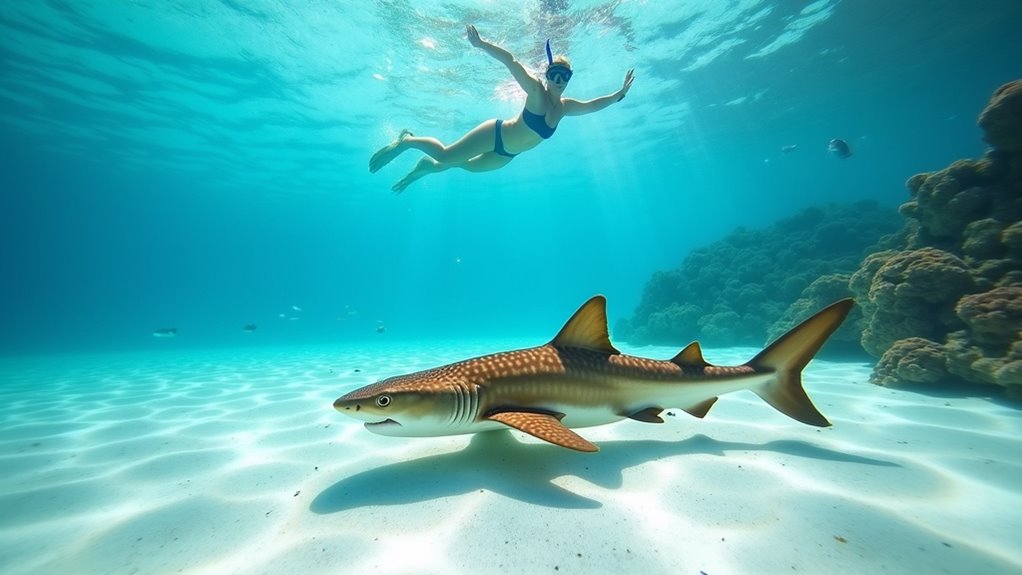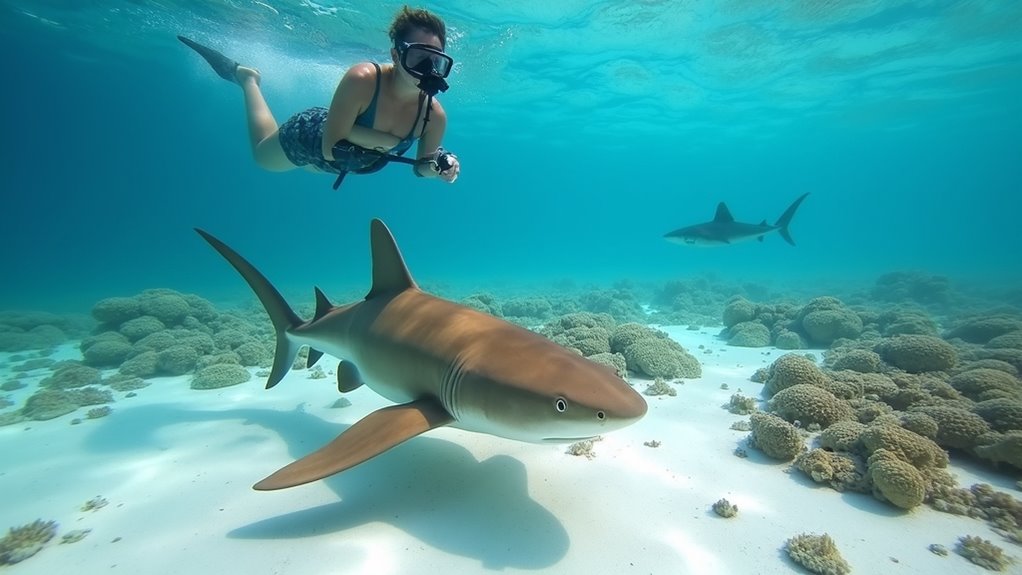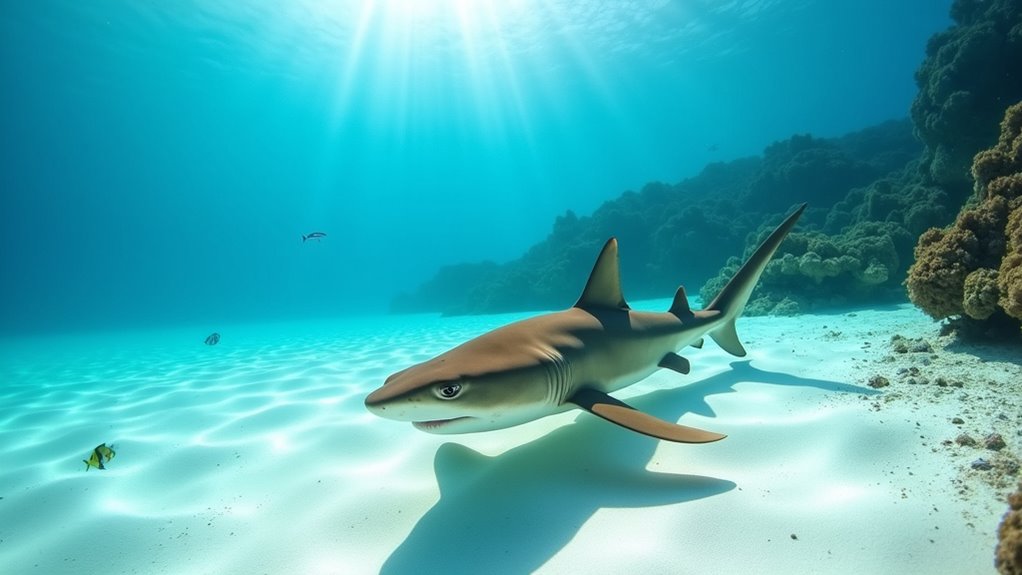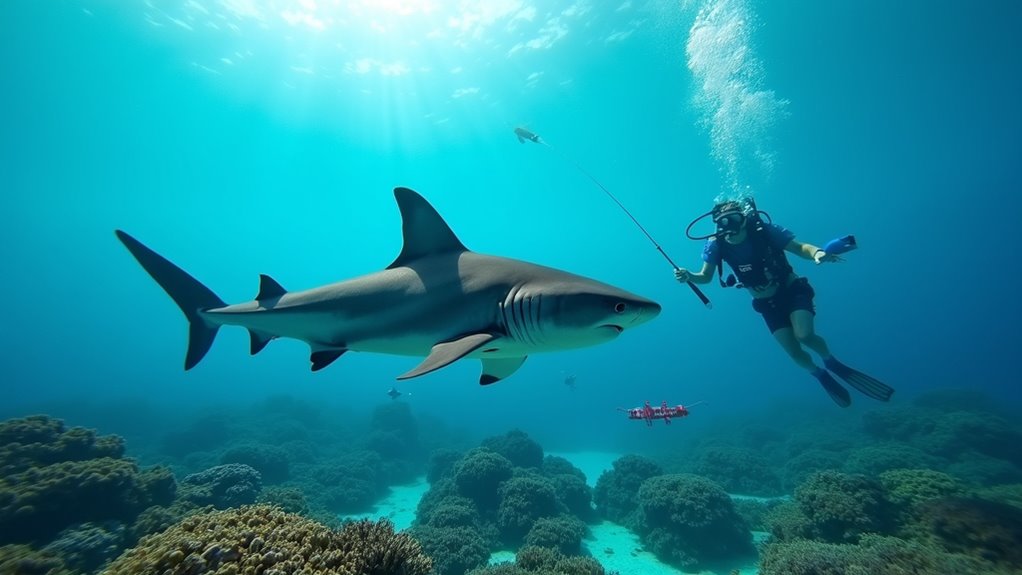Physical Address
304 North Cardinal St.
Dorchester Center, MA 02124
Physical Address
304 North Cardinal St.
Dorchester Center, MA 02124

Curious about Aruba's sharks? Discover which species lurk beneath those turquoise waters and why they're less dangerous than you might think.
Yes, Aruba has several shark species including Caribbean reef, nurse, lemon, blacktip, and occasional whale sharks. Most stay around coral reefs and shipwrecks but pose minimal risk to humans. Shark attacks are extremely rare on the island—even rarer than lightning strikes. You can safely enjoy water activities as these sharks generally avoid people and aren’t aggressive. Understanding these magnificent creatures reveals their essential role in maintaining Aruba’s thriving marine ecosystem.

While exploring Aruba’s crystal-clear waters, you might wonder what sharks lurk beneath the surface. Aruba’s waters are home to several shark species, each with distinct characteristics.
You’ll likely find the blacktip reef shark in shallow waters, reaching 3-4 feet with moderate aggression if provoked. The non-aggressive Caribbean reef shark prefers coral reefs and grows to 8-9 feet. Lemon sharks, with their distinctive yellowish color, occasionally visit Aruba’s waters, measuring 9-10 feet but posing little threat. Shark encounters in Aruba are very rare incidents as they typically inhabit areas where swimmers don’t venture.
The nocturnal nurse shark remains non-aggressive in deeper waters, growing to 7-8 feet. Most impressive is the whale shark—massive at 18-32 feet but completely harmless as a filter feeder. These gentle giants sometimes venture near shore, offering rare but spectacular sighting opportunities.
The safety record of Aruba’s waters speaks for itself when it comes to shark encounters. You’ll be relieved to know that shark attacks here are extremely rare, with only a handful of incidents throughout the island’s history.
The last notable event occurred in 2015, involving a boating accident rather than an unprovoked attack.
Your risk of encountering a shark while swimming or diving in Aruba is considerably lower than being struck by lightning. This remarkable safety record continues to support tourism and gives both locals and visitors confidence to enjoy water activities without fear.
While no specific shark safety regulations exist on the island, following general ocean safety guidelines is always recommended. Most travelers receive reassurance about the minimal risk upon arrival. Visitors can feel comfortable participating in water sports confidently due to the infrequency of shark sightings in Aruban waters.

Sharks around Aruba maintain specific habitats that you’ll want to be aware of if you’re planning to explore the island’s waters. You’ll most frequently encounter them in shallow waters around coral reefs, where they find both shelter and hunting opportunities. Rocky formations and shipwrecks also attract sharks, serving as perfect ambush points for prey.
If you’re hoping to spot sharks, marine parks and conservation zones offer your best chances, as these protected areas host higher shark populations and greater species diversity.
Caribbean reef sharks and nurse sharks show strong site fidelity, typically staying within specific territories. While they occasionally make directed journeys across their home ranges, they rarely travel between islands. The SS Antilla Wreck is particularly known for shark sightings, especially nurse sharks that often rest in groups near this popular dive site.
Understanding these patterns will help you better appreciate where and why you might encounter these magnificent creatures during your Aruba visit.
Understanding how sharks behave in Aruban waters can profoundly enhance your experience when swimming or diving around the island. Most species you’ll encounter, particularly nurse and Caribbean reef sharks, are non-aggressive and typically avoid human interaction.
While exploring Aruba’s waters, you’ll notice nurse sharks often resting in groups on sandy bottoms. Meanwhile, reef sharks patrol coral ecosystems. Lemon sharks display fascinating social structures and may be spotted in small groups in deeper areas. Blacktip sharks are commonly seen in nearshore waters near Malmok, exhibiting their characteristic skittish behavior.
Watch for warning signs of aggression like arched backs, jerky movements, or lowered pectoral fins—though these are rare. Juvenile sharks might approach out of curiosity, but this doesn’t usually indicate a threat. Even with the occasional presence of tiger or bull sharks, attacks remain extremely uncommon in Aruba.

While shark behavior informs how you interact with these creatures, conservation initiatives determine whether future generations will have the same opportunity. Aruba boasts the largest shark diversity among surveyed Dutch Caribbean islands, with eight documented species thriving in its waters.
Regional frameworks are making a difference in protecting these magnificent creatures:
Local efforts including BRUV surveys, acoustic telemetry studies, and collaboration between fishermen and scientists are building community support for shark conservation in Aruban waters.
Despite their rarity in Aruba’s waters, encountering a shark while swimming can be an alarming experience if you’re not prepared. If you spot a shark, remain calm and avoid panicking.
Slowly and steadily move toward the shore or your boat without making erratic movements or splashing.
Maintain eye contact with the shark when possible, but don’t stare aggressively. Remember that sharks often investigate by “bumping” with their snouts—this isn’t necessarily aggression.
If you’re wearing shiny jewelry, keep it covered as it might resemble fish scales.
Swimming in groups provides additional safety, as sharks typically avoid large gatherings.
Most species around Aruba such as nurse and reef sharks are non-aggressive by nature and typically avoid humans.
Once safely out of the water, alert lifeguards or authorities about the sighting to protect others.
With these precautions, you can respond appropriately to this rare occurrence.

Beyond the rare encounter that might cause momentary alarm, sharks serve a foundational role in Aruba‘s underwater world. As apex predators, they maintain the delicate balance of Aruba’s marine ecosystem by controlling populations of smaller fish and preventing overgrazing on the island’s precious coral reefs.
When you’re enjoying Aruba’s crystal waters, remember that sharks contribute to the very beauty you’re experiencing:
The Caribbean reef shark, which can grow up to 3 meters in length, is among the important species that help sustain Aruba’s marine biodiversity.
As you wade into Aruba’s crystal waters, remember that sharks are more Moby Dick than Jaws—mysterious creatures deserving respect rather than fear. You’re statistically safer swimming with these ancient mariners than driving to the beach. By keeping a respectful distance and appreciating their ecological importance, you’ll guarantee both your safety and the continued health of Aruba’s vibrant underwater paradise for generations to come.